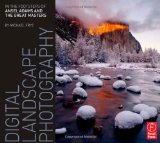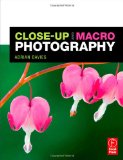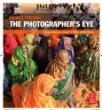Copyright ©2000-2011
The content of this site, including the
text and photographs, are the exclusive property of Steve Fredrick.
This means you are welcome to view and enjoy; however, you do NOT have
rights to copy, store, print, or republish any of the content without the
written permission of Steve Fredrick.
Let me know what you think about the site or the images. Send me an email .
Former and Current Texts
This page lists books I am currently or have used as text for photography classes. It also lists books I have read and would recommend to someone else who wants to know more about the topic. As you scroll down the page you will see the following headings: Landscape, Close-up, Photographic Composition and Creativity, and The Digital Dark Room.
Landscape Photography--It's All About the Light
Digital Landscape Photography: In the Footsteps of Ansel Adams and the Masters
 This is the text that I'm currently using in the Landscape Photography--It's All About the Light class. I like the way the author, Michael Frye, approaches the technical topics. That the geeky technical stuff is only important because of how it affected the image aesthetic.
This is the text that I'm currently using in the Landscape Photography--It's All About the Light class. I like the way the author, Michael Frye, approaches the technical topics. That the geeky technical stuff is only important because of how it affected the image aesthetic.
And he does a better than average job covering composition and light in an all-in-one book.
The Ultimate Guide to Digital Nature Photography
 This is the text that I’m currently using in the Digital SLR Essentials class. This book is intended for someone new to photography. It is quite current and does a reasonably good job covering the major photography topics in an up-to-date way: Equipment, Composition, Image Capture, Light, and Composition.
This is the text that I’m currently using in the Digital SLR Essentials class. This book is intended for someone new to photography. It is quite current and does a reasonably good job covering the major photography topics in an up-to-date way: Equipment, Composition, Image Capture, Light, and Composition.
John Shaw's Landscape Photography
 John Shaw’s books used to be the go-to books for photo enthusiasts trying to better their craft. But they was published back in '90s and have not been updated. While John’s explanations are still correct and easy to understand, they are dated. A good part of this book is dedicated to film and tools, like color correction filters, that do not apply in our digital world. But the material on exposure (even though it does not mention histograms), composition, light, and getting sharp images is all still very good. It’s still a good book to learn from; just recognize that it’s a bit dated.
John Shaw’s books used to be the go-to books for photo enthusiasts trying to better their craft. But they was published back in '90s and have not been updated. While John’s explanations are still correct and easy to understand, they are dated. A good part of this book is dedicated to film and tools, like color correction filters, that do not apply in our digital world. But the material on exposure (even though it does not mention histograms), composition, light, and getting sharp images is all still very good. It’s still a good book to learn from; just recognize that it’s a bit dated.
Close-up Photography
Close-Up and Macro Photography
 This is the book that I am currently using for my Close-Up Nature Photography class. While not what I would call an ideal text' this one is getting close. I've looked at quite a few and even read a few and for what is available now, this is the best of the bunch.
This is the book that I am currently using for my Close-Up Nature Photography class. While not what I would call an ideal text' this one is getting close. I've looked at quite a few and even read a few and for what is available now, this is the best of the bunch.
The author does a good job with equipment, technique, and light for this style photography. But, for what ever reason, hevchose not to address the topic of composition. He does however, include a chapter on digital workflow.This is a topic that deserves a complete book by itself. While, the material in this chapter is accurate, it does not go deep enough to be useful.
John Shaw's Closeups in Nature
 This is another John Shaw oldie but goodie photography books. Again, it has several sections that discuss film and related topics that are out dated. However, John’s treatment of foundations topics, close-up equipment and field techniques are excellent.
This is another John Shaw oldie but goodie photography books. Again, it has several sections that discuss film and related topics that are out dated. However, John’s treatment of foundations topics, close-up equipment and field techniques are excellent.
Macro Photography Photo Workshop
 I've been searching for a book to replace Shaw's book for my Close-ups in Nature class. When I read the reviews and the preview sections I thought I had found it. But when I read it I was a bit disappointed. Don't get me wrong, there is some good information in this book. The problem is you have to weed thought sections where the author seems to go on and on about squat. And, overall, the sample images are a bit under whelming.
I've been searching for a book to replace Shaw's book for my Close-ups in Nature class. When I read the reviews and the preview sections I thought I had found it. But when I read it I was a bit disappointed. Don't get me wrong, there is some good information in this book. The problem is you have to weed thought sections where the author seems to go on and on about squat. And, overall, the sample images are a bit under whelming.
Recommended Reading
Even though I haven't used these as text books I have found them to be useful and as such can recommend them.
Composition and Creativity
 The Photographer's Eye: Composition and Design for Better Digital Photos
The Photographer's Eye: Composition and Design for Better Digital Photos
Michael Freeman takes a very methodical and structured look at composition and image design. He also touches on the use of new tools, like panoramas and HDR, and that, in order to be effective, they still need to adhere to the concepts of composition and design.
Photographic Composition
 The authors emphasis that photography is a form of communication. And to effectively communicate visually requires the use composition. They then break down the areas a photographer needs to control as part of the design process into: Graphic Controls, Photographic Controls, Color Controls, and Tonal Controls. They then show how these controls can be used to implement various compositional concepts.
The authors emphasis that photography is a form of communication. And to effectively communicate visually requires the use composition. They then break down the areas a photographer needs to control as part of the design process into: Graphic Controls, Photographic Controls, Color Controls, and Tonal Controls. They then show how these controls can be used to implement various compositional concepts.
Within the Frame: The Journey of Photographic Vision
 In my classes I talk about photography being both a right brain, as well as, a left brain activity. Perhaps that is why my favorite quote from the book is a sub chapter title, “Gear is Good, Vision is Better.” It’s just a more sophisticated way of saying, “The photographer makes the picture, not the camera.” But at the same time drives home the point that both photographic vision and photographic technique are required to consistently make good images. I found this book to be both thought provoking and inspirational. A must read for photographers.
In my classes I talk about photography being both a right brain, as well as, a left brain activity. Perhaps that is why my favorite quote from the book is a sub chapter title, “Gear is Good, Vision is Better.” It’s just a more sophisticated way of saying, “The photographer makes the picture, not the camera.” But at the same time drives home the point that both photographic vision and photographic technique are required to consistently make good images. I found this book to be both thought provoking and inspirational. A must read for photographers.
Creative Nature and Outdoor Photography
 A practical how-to for expanding your photographic vision that will help the reader to begin making images with more impact. Brenda breaks images design down into discussions on light, vision, color, and graphical elements.
A practical how-to for expanding your photographic vision that will help the reader to begin making images with more impact. Brenda breaks images design down into discussions on light, vision, color, and graphical elements.
In addition to the informative text, the book is illustrated with some wonderful imagery.
 Brenda has an updated revised edition of this book now available. Comparing the Table of Contents and a few pages, the textual content has not changed much. However, the accompanying photographs have all been updated. Since I already own the previous edition I don't plan on purchasing the new edition. However, if you don't own the previous edition then I'd recommend getting this newer edition.
Brenda has an updated revised edition of this book now available. Comparing the Table of Contents and a few pages, the textual content has not changed much. However, the accompanying photographs have all been updated. Since I already own the previous edition I don't plan on purchasing the new edition. However, if you don't own the previous edition then I'd recommend getting this newer edition.
The Digital Darkroom
Photoshop books tend to fall into one of two different classifications. One is what I call “How-to” books. Sections tend to be short, freestanding and focus on a single technique. That is, they are simply a collection of tutorials. The sections of these books do not need to be read in order.
The other style of books are more like text books, with long chapters that explain a topic in detail. And the chapters are intended to be read in order as they often build on earlier material.
BTW, I’m not saying one is better that the other. They are just different. However, depending on how you learn you may find one style works better for you than the other.
Photoshop CS5 for Nature Photographers: A Workshop in a Book
 This one falls in the text book category with a very practical approach for photographers. One complaint that I had on the CS4 version was it's limited coverage of ACR and especially the Local Adjustment Tools. That deficiency has been fixed in this edition. It is also a little unusual in that it has sidebars that explain how do some things in Photoshop Elements. But this is most likely not going to be of any interest to a Photoshop user and does not have enough meat to make it worth buying the book for an Elements user. But it is a good book for photographers using Photoshop.
This one falls in the text book category with a very practical approach for photographers. One complaint that I had on the CS4 version was it's limited coverage of ACR and especially the Local Adjustment Tools. That deficiency has been fixed in this edition. It is also a little unusual in that it has sidebars that explain how do some things in Photoshop Elements. But this is most likely not going to be of any interest to a Photoshop user and does not have enough meat to make it worth buying the book for an Elements user. But it is a good book for photographers using Photoshop.
Real World Camera Raw with Adobe Photoshop CS5
 This the not only the definitive book on Adobe Camera Raw and how to effectively develop you raw files. It also covers the raw file format to better understand things like highlight recovery. It also covers a raw workflow using Bridge. If you don't use Lightroom this is a must have book for understanding a raw workflow using Bridge and ACR.
This the not only the definitive book on Adobe Camera Raw and how to effectively develop you raw files. It also covers the raw file format to better understand things like highlight recovery. It also covers a raw workflow using Bridge. If you don't use Lightroom this is a must have book for understanding a raw workflow using Bridge and ACR.
Jeff Schewe has done a good job of picking up where Bruce Fraser left off.
The Adobe Photoshop Lightroom 3 Book for Digital Photographers (Voices That Matter)
 Truth be told, before reading the Lightroom 2 version of this book I was not a Scott Kelby fan. His books, articles, and videos were over the top with slapstick. I understand that learning applications like Photoshop and Lightroom are dry and a little humor can help the learning process. But in previous book it was just too much.
Truth be told, before reading the Lightroom 2 version of this book I was not a Scott Kelby fan. His books, articles, and videos were over the top with slapstick. I understand that learning applications like Photoshop and Lightroom are dry and a little humor can help the learning process. But in previous book it was just too much.
However, without this book I probably would have given up on using Lightroom 2. Even though this is written in the step-by-step how-to style (that Scott is famous for) he takes an in depth view of how to use Lightroom 2 to implement a workflow from injection into the computer through organizing images into final output via both print or display based.
While I have not read this newer version of Scott's book I've got to believe that it is as good as the previous one. So this would become my second favorite Lightroom 3 book.